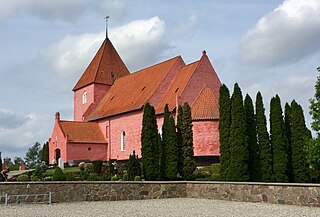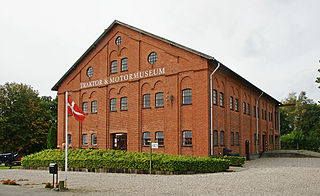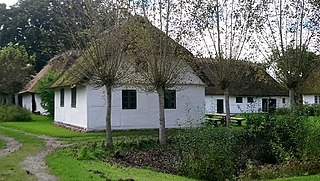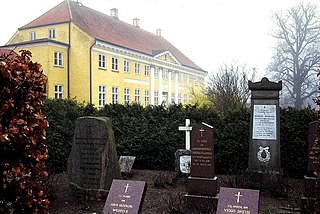Related Research Articles

Maribo is a town in Lolland Municipality in Region Sjælland on the island of Lolland in south Denmark. It was the municipal seat of the former Maribo Municipality, until 1 January 2007, and then it became the seat of the current Lolland Municipality.

Nakskov is a market town on the island of Lolland in south Denmark. The town has a population of 12,456 and is the largest town on the island of Lolland. It is located in Lolland municipality in Region Sjælland.

Maribo Abbey, established in 1416, was the first Bridgettine monastery in Denmark and became one of the most important Danish abbeys of the late Middle Ages. It was located in the present town of Maribo on the island of Lolland in southern Denmark. The monastery is in ruins, but the abbey church still remains in use as Maribo Cathedral.

Lolland is the fourth largest island of Denmark, with an area of 1,243 km2 (480 sq mi). Located in the Kattegat, Belts and Sund area, it is part of Region Sjælland. As of 1 January 2022, it has 57,618 inhabitants. Lolland is closely connected to the island of Falster to its east. The locality of Sundby forms a cross-island urban area with Nykøbing Falster, the largest conurbation partially on Lolland. The most populated settlement on Lolland proper is Nakskov.

Maribo Cathedral is a Lutheran cathedral church built in the Gothic style in Maribo on the island of Lolland in the southeast of Denmark. It was originally part of Maribo Abbey which was founded in the early 15th century. The chancel, the oldest section of the cathedral, probably dates from 1416. The plan of the church is unusual in that the chancel is at the west end of the building rather than the east as a result of the design instructions left by Saint Bridget.

Lolland Falster Airport, also known as Maribo Airport, is an airport between the towns of Holeby and Rødby south of Maribo on the island of Lolland in Denmark.

The Diocese of Lolland–Falster is a diocese within the Evangelical Lutheran Church of Denmark. It comprises Lolland and Falster as well as a number of smaller islands in the south-eastern corner of Denmark. The diocese was disjoined from the Diocese of Funen in 1803 and is the smallest of the 10 dioceses within the Danish state church. The main church is Maribo Cathedral in Maribo but the bishop resides in Nykøbing Falster.

Tingsted Church, located on high ground in the village of Tingsted on the Danish island of Falster, dates from c. 1200. Built in the Romanesque style, it is best known for its frescos from the end of the 15th century.

Falsters Minder is the city museum of Nykøbing on the Danish island of Falster. It is housed in the 17th century half-timbered building known as Czarens Hus.

Danmarks Traktormuseum is located in Eskilstrup on the Danish island of Falster. The tractor and motor museum is housed in a brick warehouse dating from 1918. It contains tractors and engines built between 1880 and 1960 by Bukh, Ferguson, Fiat, Ford, and Volvo.

Maribo Open-Air Museum is a museum located on the western outskirts of Maribo on the Danish island of Lolland. It is located 1 kilometre (0.62 mi) from Torvet, to the west of the Maribo Sø Camping site and oak woodland, near the northern banks of Søndersø Lake. It is the third oldest open-air museum in Denmark, and is in the backdrop of the Maribo Lakes Nature Park. Located on Meinckesvej, Maribo, the museum is open to visitors from 1 May to 30 September every day except Monday from 10 am to 4 pm.

Nørreballe is a village on the Danish island of Lolland. With a population of 478, it is located 6 km (3.7 mi) northwest of Maribo. The village of Østofte with its 14th-century Østofte Church is now part of Nørreballe.

Hunseby Church is located in the village of Hunseby some 3 km north of Maribo on the Danish island of Lolland. Built in the middle of the 12th century, the church has a Romanesque chancel and nave and a Gothic tower.

Hunseby is a village located some 3 km (1.9 mi) north of Maribo on the Danish island of Lolland. It belongs to Lolland Municipality in Region Sjælland. As of 2023, it has a population of 384.

Sandby Church is located in the village of Sandby some 7 km northwest of Nakskov on the Danish island of Lolland. Dating from the middle of the 13th century, the church has a Romanesque chancel and nave and a Late Gothic tower.

Pederstrup is a historic manor house located 12 km (7.5 mi) north of Nakskov on the Danish island of Lolland. The half-timbered building from 1686 was rebuilt from 1813 to 1822 in the Neoclassical style by the statesman Christian Ditlev Frederik Reventlow. Since 1940, it has housed the Reventlow Museum.

Engestofte is a Neoclassical manor house located 6 km (4 mi) east of Maribo, Lolland Municipality, on the island of Lolland in southeastern Denmark.

Danish national road 9 is part of the Danish national road network. It runs between Odense on Funen and Nykøbing Falster on Falster by way of Svendborg, Tåsinge, Siø and Langeland, and involves a ferry crossing between Langeland and Lolland.

Højbygaard Sugar Factory was built in 1872–74 at Holeby on Lolland in southeastern Denmark. It was one of the first modern sugar factories built for the country's emerging sugar beet industry. It was taken over by De Danske Sukkerfabrikker in 1877 and operated until 1959. The buildings were then acquired by De Forenede Papirfabrikker and operated as a paper mill under the name Højbygaard Papirfabrik from 1960 to 1993.
Else-Marie Boyhus is a Danish food historian. Her research has focused on her country's cooking and food production throughout history. In addition to publishing about the history of food, she has managed several museums and served as the chair of the Danish Museum Board. She is a member of the Danish Gastronomic Academy and co-editor of the academy's gastronomic lexicon.
References
- ↑ "Lolland-Falsters Stiftsmuseum", Den Store Danske. (in Danish) Retrieved 23 June 2013.
- ↑ "Stiftsmuseum", Visit Denmark. Retrieved 23 June 2013.
- ↑ "Stiftsmuseet kommer til Maribo", Museum Lolland-Falster. (in Danish) Retrieved 23 June 2013.